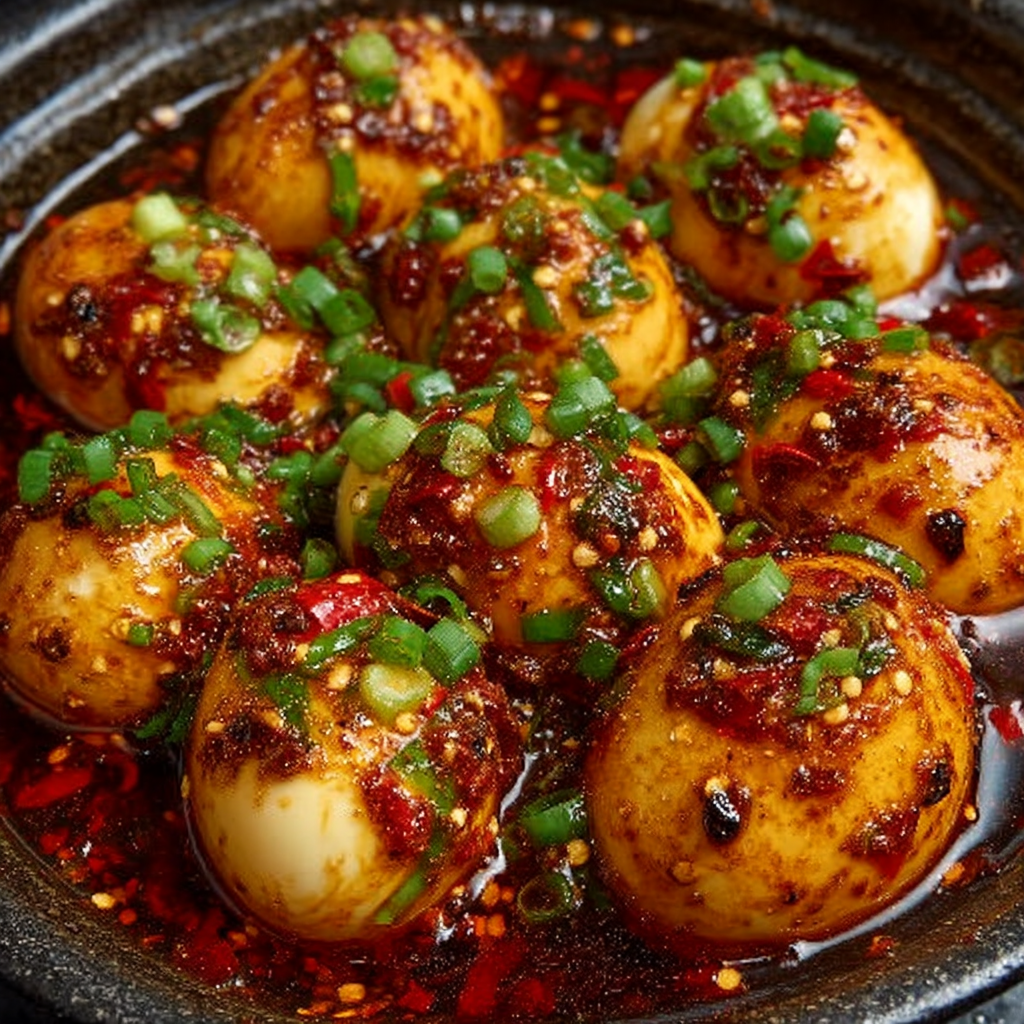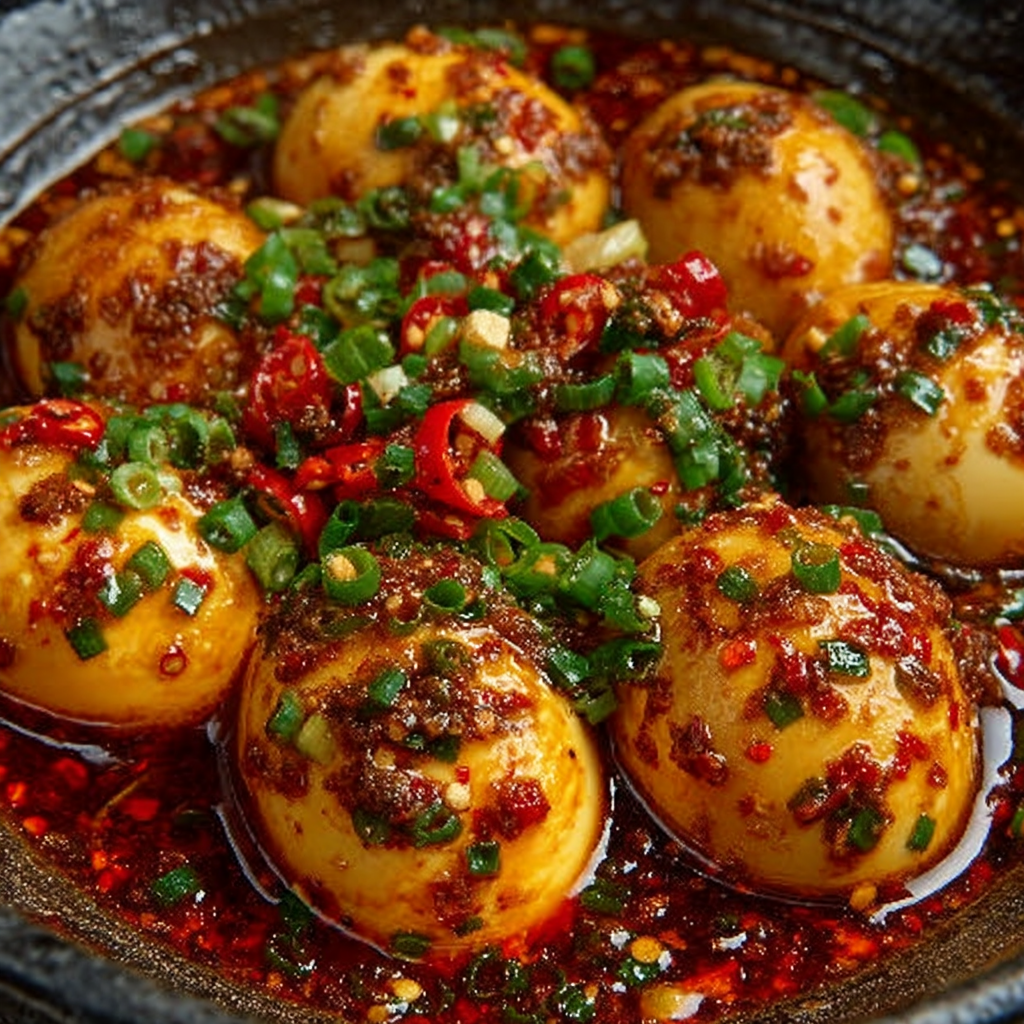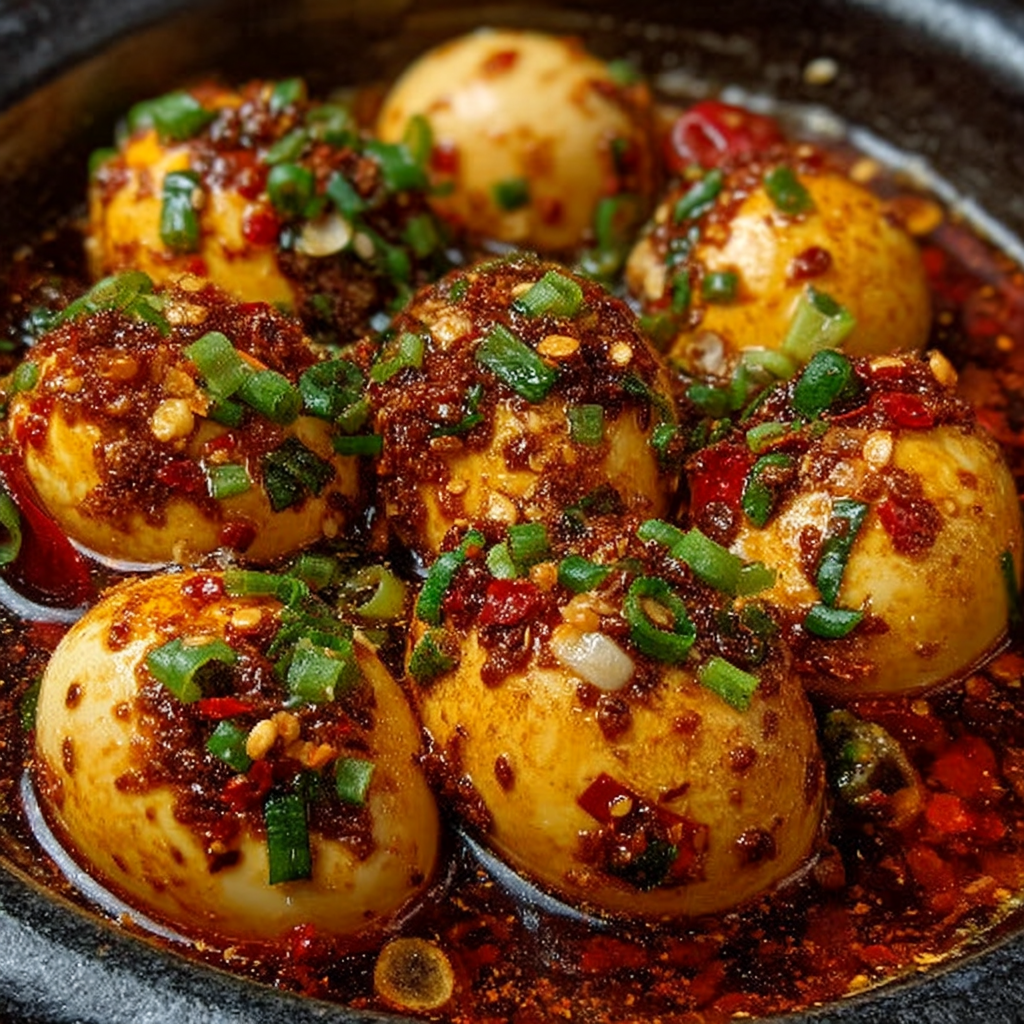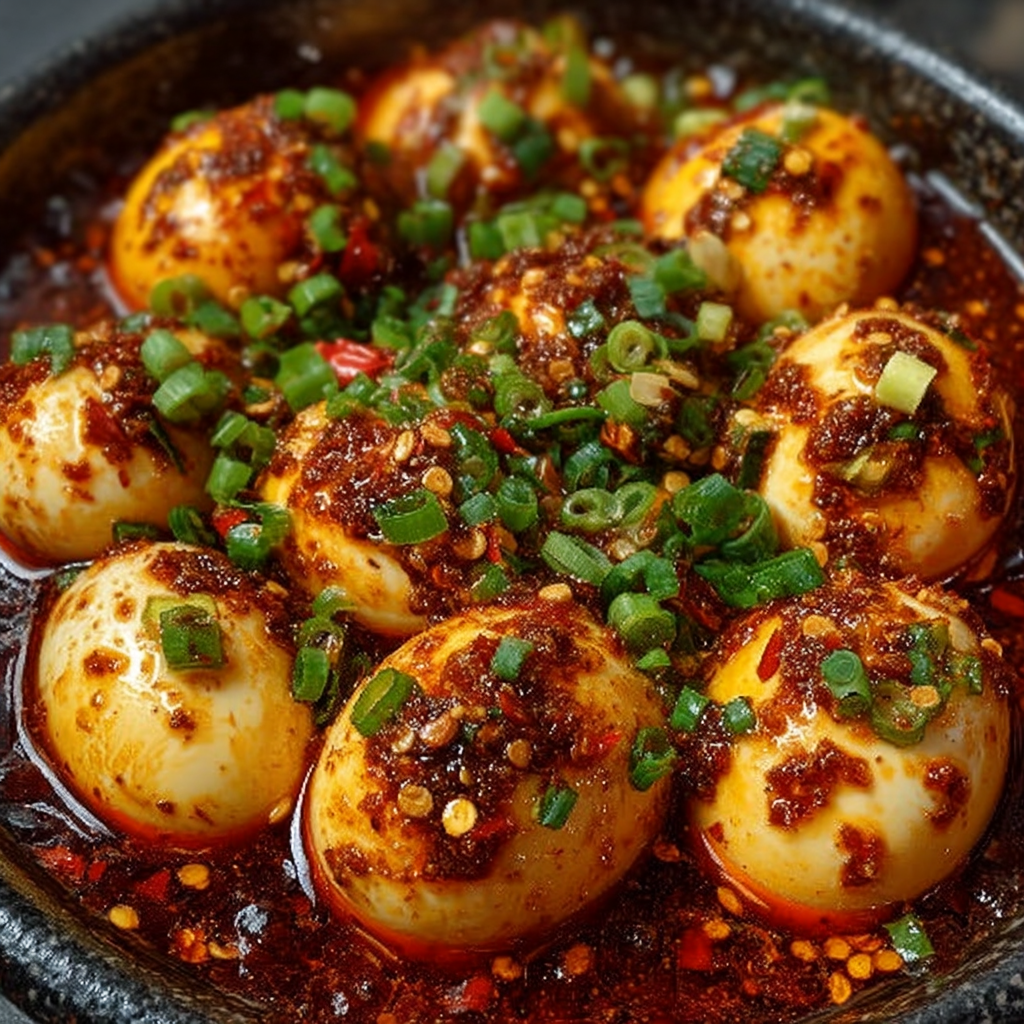1. Introduction to the Recipe
Meet your new breakfast obsession: Gochujang Butter Eggs. This dish combines perfectly cooked eggs with a luscious, savory-spicy sauce made from Korean gochujang, butter, garlic, and dashi. It’s rich, bold, and deeply satisfying — the kind of meal that looks fancy but comes together in under 30 minutes.
Imagine the creamy yolk of soft-boiled eggs meeting a glossy gochujang butter glaze that’s equal parts spicy, garlicky, and umami. The balance of butter and Korean chili paste creates an unforgettable harmony: slightly smoky, slightly sweet, and utterly crave-worthy. Whether spooned over jasmine rice or spread on crispy sourdough toast, these Gochujang Butter Eggs elevate the humble egg to a restaurant-worthy meal.
The beauty of this recipe is how approachable it is. You don’t need complex ingredients or special equipment — just eggs, butter, gochujang, and a few flavor-building staples. It’s ideal for busy mornings, quick lunches, or even as a satisfying late-night bite.
If you love globally inspired comfort food, try pairing these eggs with our Korean-Inspired Chicken Rice Bowls or Spicy Garlic Butter Noodles. Together, they make an easy yet impressive Asian-fusion spread.
Whether you’re a spice lover or just looking to shake up your breakfast routine, Gochujang Butter Eggs deliver layers of flavor in every bite — creamy, spicy, and irresistibly buttery.
2. Basic Recipe: Ingredients and Instructions
Print
Gochujang Butter Eggs
Description
Gochujang Butter Eggs — soft-boiled eggs draped in spicy garlic butter gochujang sauce, perfect over rice or toast.
Ingredients
For the Eggs:
- 6 large eggs
- 2 tablespoons apple cider vinegar
- 1½ teaspoons kosher salt (Diamond Crystal preferred)
For the Gochujang Butter Sauce:
- 4 tablespoons salted butter
- ½ tablespoon avocado oil
- ¼ cup garlic, minced (fresh only — no bottled)
- 1½ tablespoons shallot, finely minced
- 2½ teaspoons gochugaru (Korean red pepper flakes)
- 1 tablespoon gochujang (Korean chili paste)
- 2½ teaspoons light brown sugar
- 2½ teaspoons soy sauce
- ¾ cup dashi stock (or substitute chicken broth)
For Garnish:
- Fresh chives, chopped
To Serve:
- Jasmine rice or toasted sourdough bread
Instructions
Step 1 – Boil the Eggs
- Bring a medium pot of water to a boil. Add vinegar and salt.
- Gently lower eggs into the water with a slotted spoon.
- Boil for 7 minutes for jammy eggs or 9 minutes for fully set yolks.
- Immediately transfer to an ice bath to stop cooking. Let sit for 5 minutes.
- Peel carefully and set aside.
Step 2 – Make the Gochujang Butter Sauce
6. In a large skillet or sauté pan, heat avocado oil and butter over medium heat.
7. Add minced garlic and shallot; cook for 1–2 minutes until fragrant and golden (not browned).
8. Stir in gochugaru and toast briefly for 30 seconds to release aroma.
9. Add gochujang, brown sugar, and soy sauce, stirring to combine.
10. Slowly pour in dashi stock, whisking to create a smooth, glossy sauce.
11. Simmer for 3–4 minutes until slightly thickened and aromatic.
Step 3 – Combine and Serve
12. Slice eggs in half and nestle them into the sauce, spooning some over the top.
13. Simmer gently for 1 minute to warm through.
14. Garnish with chopped chives.
Step 4 – Serving Suggestions
15. Serve immediately over jasmine rice for a complete meal or spoon the eggs and sauce over toasted sourdough bread for a brunch-style presentation.
Notes
Always use fresh garlic, not jarred — it’s crucial for the authentic aroma.
If you like more heat, add an extra pinch of gochugaru or a drizzle of chili oil.
For a creamy variation, stir in 1 teaspoon of heavy cream at the end to mellow the spice.
Keywords: Gochujang Butter Eggs
3. Advanced Techniques
1. Mastering the Perfect Soft-Boiled Egg
Timing is everything. Use eggs straight from the fridge and cook exactly 7 minutes for jammy yolks. Adding vinegar to the boiling water helps the shells peel easily. Shock immediately in an ice bath — it halts the cooking and keeps yolks vibrant and creamy.
2. Building Umami Depth
Dashi stock adds savory complexity that water or plain broth can’t match. If you don’t have dashi, dissolve ½ teaspoon of fish sauce or miso paste into the stock. These ingredients amplify the umami layers that make the sauce addictively rich.
3. Perfecting the Gochujang Balance
Gochujang is a fermented chili paste with sweetness, heat, and tang. The key is balance — combine it with butter for smoothness, brown sugar for caramelized sweetness, and soy sauce for saltiness. Adjust to your spice tolerance by adding more or less gochugaru.
4. Toasting the Aromatics
Toasting garlic and shallots in butter before adding the sauces builds a deep, nutty aroma. Keep the heat moderate — burned garlic turns bitter quickly. You want it fragrant and golden, not brown.
5. Serving Temperature and Texture
The sauce should be thick enough to coat the back of a spoon but not heavy like gravy. When serving over rice, keep it warm enough to lightly melt into the grains. If serving over toast, slightly reduce the sauce for a more concentrated glaze.

4. Storage, Shelf Life, and Maintenance Tips
1. Refrigeration
Store cooked eggs and sauce separately in airtight containers. They’ll last up to 3 days in the refrigerator. Combine and reheat gently before serving.
2. Reheating
Warm sauce in a skillet over low heat. Add a splash of dashi or water if it thickens. Reheat eggs by briefly dipping them in warm water for 1–2 minutes — this preserves the texture without overcooking.
3. Freezing
Not recommended for this recipe — eggs and butter sauce both lose quality after thawing.
4. Maintaining Fresh Flavor
If storing overnight, refresh the sauce before serving by adding a small knob of butter and a sprinkle of fresh garlic or chili flakes.
5. Leftover Transformation
Use leftover sauce as a base for fried rice or drizzle over roasted vegetables. It also makes a fantastic stir-fry glaze for tofu or shrimp.

5. Dietary Adaptations and Substitutions
1. Vegetarian Version
Replace dashi with vegetable broth and use a touch of miso paste to replace the umami depth from fish-based stock.
2. Dairy-Free Adaptation
Use vegan butter or olive oil instead of regular butter. The flavor remains rich, though slightly less creamy.
3. Gluten-Free Version
Use tamari or coconut aminos instead of soy sauce. Ensure gochujang is labeled gluten-free, as some brands contain barley or wheat.
4. Low-Sodium Option
Reduce soy sauce by half and use unsalted butter. Brighten with lemon juice or rice vinegar at the end to maintain flavor balance.
5. Extra-Spicy Version
For heat lovers, add 1 teaspoon of chili crisp or a few drops of Korean chili oil to the finished sauce. The oil adds a fiery layer without overpowering the buttery base.

6. FAQs About the Recipe
1. What is gochujang?
Gochujang is a Korean chili paste made from fermented soybeans, glutinous rice, and red pepper flakes. It adds depth, spice, and sweetness all at once — a must-have for authentic Korean flavors.
2. Can I use gochujang substitutes?
If unavailable, mix 2 tablespoons of miso paste with 1 teaspoon of chili powder and a touch of honey. It won’t be identical but gives similar umami and spice.
3. Can I make this with fried or scrambled eggs?
Yes! Pour the gochujang butter sauce over sunny-side-up eggs or stir it into soft scrambled eggs for a comforting breakfast variation.
4. How spicy is this dish?
Mild to medium. The butter, sugar, and dashi balance the gochujang’s heat. Adjust spice by controlling the amount of gochugaru or substituting sweet paprika.
5. Can I prepare it ahead of time?
You can boil eggs and make the sauce a day ahead. Store separately and combine right before serving to keep the texture and flavor fresh.

7. Conclusion & Final Thoughts
Gochujang Butter Eggs prove that simple ingredients can create restaurant-level magic when balanced just right. The buttery, garlicky sauce wraps around each soft-boiled egg like velvet, while the gochujang adds a deep, spicy-sweet undertone that makes every bite unforgettable.
This dish bridges comfort and sophistication — equally at home on a brunch table or a quiet solo lunch. The combination of eggs, butter, and chili paste delivers richness without heaviness, while the dashi infuses it with a subtle umami punch.
Serve it over steaming jasmine rice for a comforting Korean-inspired meal, or spoon it over toast for a European-style fusion breakfast. Add a side of kimchi, avocado, or even roasted veggies to complete the plate.
The best part? This meal comes together in less than 30 minutes but tastes like it’s been simmering all morning. It’s bold, flavorful, and incredibly rewarding — the perfect reminder that simple doesn’t have to mean boring.
Once you try these Gochujang Butter Eggs, they’ll earn a permanent place in your comfort-food rotation. Creamy, spicy, and buttery — a true taste of global comfort in every bite.
